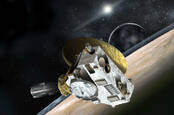This article is more than 1 year old
Today's good news is that whoever has to clean up Solar System will have an easy job: Lack of small debris in Kuiper belt
None of that tiny space rubble to sweep away, judging by snaps of Pluto's acne spots
The Solar System's Kuiper belt, a donut-shaped pile up of debris extending beyond Neptune, contains a surprisingly lack of small objects, judging from images of Pluto and its moon Charon.
The pics were taken by NASA’s New Horizons spacecraft, which blasted off from Earth in 2006, and made it out to the edges of the Solar System in 2015 to snap closeups of the dwarf planet and its moon. These photos revealed craters where objects in the surrounding Kuiper belt have smashed into the larger bodies.
A team of researchers led by the Southwest Research Institute (SwRI), a non-profit based in Texas, took a look at the photos of the dents, and now believe the craters on Pluto and Charon show that small Kuiper belt objects (KBOs) are rare.
How do they know? Well, the impact craters range from 300 metres to 40 kilometres across, and there are few at the low end, suggesting there are or were not that many small KBOs whirling around the belt to crash into Pluto and its moon.
That means, unlike belts of cosmic rocks elsewhere in the Solar System that have a mix of object sizes, the Kuiper belt is where only the big hunks of rubble play.
“This surprising lack of small KBOs changes our view of the Kuiper Belt and shows that either its formation or evolution, or both, were somewhat different than those of the asteroid belt between Mars and Jupiter,” said Kelsi Singer, first author of a paper published today in Science describing the discovery, and a senior research scientist at SwRI.
“Perhaps the asteroid belt has more small bodies than the Kuiper Belt because its population experiences more collisions that break up larger objects into smaller ones.”
The Solar System formed about 4.6 billion years ago as a giant molecular cloud or solar nebular that gravitationally collapsed in on itself. First, the Sun began to form and the material around it coalesced into a disk. As the young star grew in mass by gobbling the disk, the remaining debris inside of the disk also began clumping together to form planets, satellites, and all the other bundles of dust, rock and ice.
The Kuiper belt and asteroid belt contain remnants of chunks of matter that once made up the protoplanetary disk. Unlike the Kuiper belt, however, the asteroid belt has objects as large as Ceres, considered a dwarf planet at 946 kilometres in diameter, to small bits of stuff measuring just a few metres across in size.
"This lack of small KBOs seems to support models of Solar System formation that do not produce a lot of small objects," Singer explained to The Register.
"Models where material in the solar nebula collapses into bigger objects more quickly are supported by this new data. As opposed to models where everything grows very slowly from small objects up to medium sized objects up to large objects."
Since some of the patches on Pluto’s and Charon’s surfaces are pristine, having been untouched for more than 4 billion years, the researchers can estimate the size and frequency of KBOs over time. Singer told El Reg the team are currently studying Ultima Thule, an object in the Kuiper belt, to inspect its surface. It's early days yet, but it looks like it doesn't have a lot of small craters either.
“This breakthrough discovery by New Horizons has deep implications,” said Alan Stern, principal investigator of the New Horizons mission. “Just as New Horizons revealed Pluto, its moons, and more recently, the KBO nicknamed Ultima Thule in exquisite detail, Dr Singer’s team revealed key details about the population of KBOs at scales we cannot come close to directly seeing from Earth.” ®

